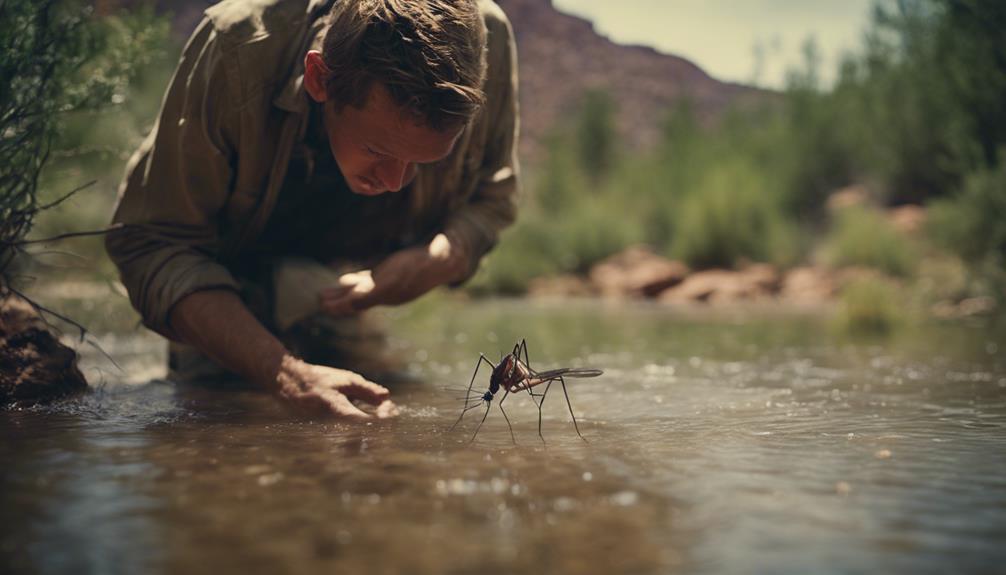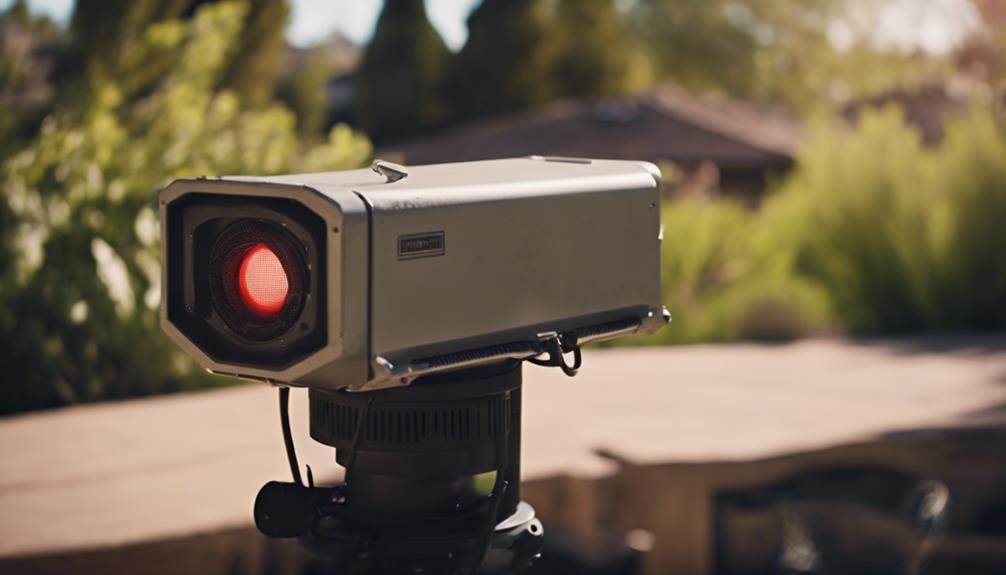Combatting mosquito-borne diseases in Southern Utah is essential. Aedes aegypti mosquitoes, prevalent in the region, can transmit Zika and Dengue. Excessive rainfall fosters their breeding. Southwest Mosquito Abatement District actively fights infestations. To minimize risks, eliminate standing water and implement precautions. West Nile virus, common in Southern Utah, can lead to severe complications. Recognizing symptoms early and seeking prompt treatment are important. Preventive measures include insect repellent and protective clothing. Controlling mosquito populations is key. Stay informed to protect yourself.
Key Takeaways
- Aedes mosquitoes transmit Zika and Dengue in Southern Utah.
- Excessive rainfall fosters Aedes mosquito breeding.
- West Nile virus is prevalent, causing fever and body aches.
- Neurological complications can arise from severe cases.
- Prompt medical attention is crucial to prevent severe outcomes.
Mosquito-Borne Diseases in Southern Utah: Overview

In Southern Utah, the prevalence of mosquito-borne diseases, particularly those transmitted by aggressive Aedes aegypti mosquitoes, is escalating due to favorable breeding conditions and vital human host preference. The excessive rainfall in the region creates ideal environments for Aedes mosquitoes to breed, leading to a surge in their population. Aedes mosquitoes, infamous for their multiple bites on humans, are carriers of tropical fevers such as Zika and Dengue. Their preference for human blood and ability to lay eggs in stagnant water contribute to their swift population growth.
The Southwest Mosquito Abatement District is actively combating the rise of Aedes infestations in Southern Utah to mitigate disease transmission risks. By targeting breeding grounds and implementing control measures, the district aims to curb the spread of mosquito-borne illnesses in the region. It’s essential for residents to be vigilant, eliminate standing water around their homes, and follow recommended precautions to reduce the risk of contracting these dangerous diseases.
Common Mosquito-Borne Illnesses in the Region
West Nile virus is a prevalent mosquito-borne illness in Southern Utah, presenting symptoms like fever, headache, and body aches, with severe cases leading to neurological complications.
Treatment involves supportive care, as no specific antiviral medication exists for West Nile virus.
Preventive measures such as using insect repellent, wearing long sleeves, and eliminating standing water are essential in reducing the risk of mosquito-borne diseases transmission.
Disease Prevalence in Utah
Amidst the diverse array of mosquito-borne illnesses present in Southern Utah, several common diseases pose a significant threat to public health.
In Utah, West Nile virus stands out as a major concern, with 5 neuroinvasive cases reported in 2022 alone. Although less than 1% of infected individuals may develop severe complications from West Nile virus, the potential impact on public health remains substantial.
Additionally, other wildlife-related diseases such as Hantavirus, plague, and tularemia are also prevalent in Utah. While locally acquired malaria cases have been reported in states like Florida, Texas, and Maryland, the presence of a significant mosquito population in Utah underscores the importance of understanding disease prevalence to mitigate the risks associated with these zoonotic and vector-borne illnesses.
Symptoms and Treatment
Several common mosquito-borne illnesses in Southern Utah present with symptoms such as fever, headache, body aches, and rash. In severe cases, these illnesses can lead to neurological issues like encephalitis or meningitis. Seeking essential medical treatment is vital for managing symptoms and preventing complications.
Antiviral medications or supportive care may be used to treat severe mosquito-borne illnesses. Early recognition of symptoms is key, as it can lead to better outcomes for affected individuals. If you experience symptoms like fever, headache, body aches, or rash after a mosquito bite in Southern Utah, it’s important to consult a healthcare provider immediately for proper evaluation and treatment to prevent any potential neurological complications.
Prevention Methods
To effectively combat the spread of mosquito-borne illnesses in Southern Utah, implementing preventive measures such as using insect repellent, wearing protective clothing, and eliminating standing water sources is essential. The primary mosquito-borne illnesses in the region, including West Nile virus, Zika, and Dengue fever, pose significant health risks.
Aedes aegypti mosquitoes, carriers of tropical fevers, thrive in Southern Utah due to favorable breeding conditions. Timely reporting of day-biting mosquitoes to local abatement districts is important to prevent disease transmission.
Public health advisories play an important role in raising awareness about the risks associated with mosquito-borne illnesses. By following these preventive strategies and staying informed, individuals can reduce their chances of contracting these potentially dangerous diseases.
Impact of Mosquito-Borne Diseases on Public Health
The impact of mosquito-borne diseases on public health in Southern Utah is an urgent concern that requires vigilant monitoring and proactive intervention strategies. Mosquito-borne diseases, including West Nile virus and Zika, pose a significant public health risk in Southern Utah due to the potential for local transmission and the severe health consequences that can result if left unchecked.
The presence of aggressive Aedes mosquitoes in the region further heightens the risk of disease transmission to humans. Public health advisories and ongoing mosquito abatement efforts are vital in mitigating the spread of these diseases.
Early detection, timely reporting of mosquito activity, and the implementation of proactive prevention measures are essential steps to safeguard public health in Southern Utah. By staying informed, actively participating in prevention efforts, and promptly addressing any signs of mosquito-borne illnesses, individuals can contribute to the overall health and well-being of the community.
Preventive Measures Against Mosquito-Borne Diseases
To safeguard yourself against mosquito-borne diseases, make sure to use insect repellent containing 20-30% DEET and wear long clothing when in mosquito-prone areas.
Removing standing water sources around your property and adding dish soap to water can help control mosquito populations.
Reporting day-biting mosquitoes promptly to the Southwest Mosquito Abatement District is vital for identifying and managing breeding sites.
Protective Clothing Options
Maximize your protection against mosquito-borne diseases by utilizing a combination of appropriate clothing options designed to deter mosquito bites effectively. When choosing protective clothing, consider these options:
- Permethrin-treated clothing: Provides additional protection by repelling and killing mosquitoes on contact.
- Light-colored clothing: Helps in spotting mosquitoes easier, reducing the risk of bites.
- Tightly woven fabrics: Fabrics like polyester or nylon are more effective at preventing mosquito bites than loose or thin materials.
Effective Repellent Choices
When enhancing your protection against mosquito-borne diseases, consider selecting repellents with DEET or Picaridin as effective ingredients to ward off mosquito bites and reduce the risk of potential illnesses.
Using insect repellents containing 20-30% DEET can provide long-lasting protection against mosquito-borne illnesses. Choosing repellents with Picaridin can offer an alternative to DEET for those with skin sensitivities or preferences.
Applying repellent to exposed skin and clothing can notably reduce the risk of mosquito bites and disease transmission in mosquito-prone areas. Selecting a repellent with a higher concentration of active ingredients can provide extended protection during outdoor activities in mosquito-infested regions.
Make informed decisions when choosing mosquito repellents to safeguard yourself during outdoor ventures.
Mosquito Control Strategies in Southern Utah
Mosquito control strategies in Southern Utah involve the Southwest Mosquito Abatement and Control District responding promptly to Aedes infestations through rigorous inspection, trapping, identification, and targeted treatment measures. To combat the influx of invasive mosquitoes and reduce the risk of mosquito-borne diseases, the following key strategies are implemented:
- Inspect and Treat Stagnant Water: Teams actively search for stagnant water sources, such as containers and pools, to prevent mosquito breeding grounds.
- Utilize Insecticides and Bacterial Products: Infected areas are treated with insecticides or bacterial products to control mosquito populations effectively.
- Distribute Public Health Advisories: Door-to-door dissemination of public health advisories raises awareness about the presence of invasive mosquitoes, educating residents on preventive measures.
Recognizing Symptoms of Mosquito-Borne Diseases
To identify potential mosquito-borne diseases, recognizing their symptoms is vital for prompt medical intervention and treatment. Symptoms of mosquito-borne diseases typically include fever, headache, body aches, and fatigue. In more severe cases, individuals may experience neurological symptoms such as confusion, tremors, and paralysis.
Additional signs to watch for include skin rashes, swollen lymph nodes, and nausea, which can all indicate the presence of mosquito-borne illnesses. If you experience any of these symptoms following a mosquito bite, especially in high-risk areas, it’s essential to seek medical attention promptly.
Early diagnosis and treatment play a pivotal role in preventing complications that may arise from mosquito-borne diseases. By being vigilant and recognizing these symptoms early on, you can take the necessary steps to receive appropriate treatment and care, ultimately safeguarding your health and well-being.
Seeking Treatment for Mosquito-Borne Illnesses
Seeking timely medical treatment for mosquito-borne illnesses is critical in preventing complications and ensuring effective management of the infection. When experiencing symptoms of mosquito-borne diseases, it’s essential to seek medical intervention promptly. Delaying treatment can lead to severe outcomes and worsen the condition.
- Early diagnosis by healthcare professionals is key to initiating appropriate treatment.
- Symptoms such as fever, body aches, rash, and fatigue shouldn’t be ignored and warrant medical attention.
- Proper and timely treatment can help prevent complications associated with mosquito-borne illnesses.
Frequently Asked Questions
What Diseases Do Mosquitoes Carry in Utah?
Mosquitoes in Utah can carry various diseases, including West Nile, Zika Virus, Chikungunya Fever, Dengue Fever, Yellow Fever, Eastern Equine, La Crosse, and Western Equine. Protect yourself by using repellents, wearing long sleeves, and eliminating standing water.
Why Are Mosquitoes so Bad This Year in Utah?
This year, the mosquito population in Utah is soaring due to favorable climate conditions. To combat disease transmission, focus on prevention methods like efficient mosquito control. Addressing environmental factors is essential for public health and containing local outbreaks.
Is There Malaria in Utah?
In Utah, malaria isn’t a significant concern. The state sees few cases, mainly from travelers. Preventive measures like medications and bite precautions are essential. Local transmission would be rare due to mosquito species and climate.
What Are the Threats to Mosquito-Borne Diseases?
To mitigate mosquito-borne diseases in Southern Utah, prioritize prevention methods like vector control and community education. Understand risk factors tied to outdoor activities. Climate change intensifies disease transmission, highlighting the urgency for public health initiatives.




